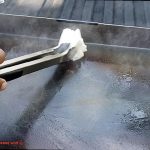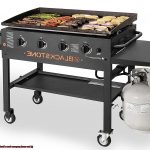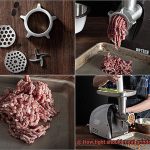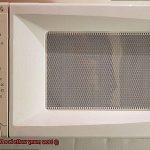Are you a meat lover who wants to take their culinary game to the next level? Then, you know that grinding your own meat is the way to go. However, adjusting your meat grinder can be daunting. The question on everyone’s mind is, “How tight should my meat grinder be?”
Well, it’s not a straightforward answer. The tightness of your meat grinder is essential to the quality of your grind but isn’t one-size-fits-all. It depends on several factors like the type of meat, texture of the grind, and type of grinder.
In this post, we’ll dive into how to adjust your meat grinder for a perfect grind every time – from fine-textured sausage to chunky burger meat. We’ll also talk about different types of grinders and attachments available in the market.
But wait, there’s more. We’ll walk you through step-by-step instructions on how to adjust your machine for that perfect grind you’ve been craving.
So whether you’re new in the world of meat grinding or a seasoned pro looking for some tips and tricks, keep reading. Get ready to elevate your cooking game with our expert advice on getting the best possible results from your meat grinder.
Contents
Overview of Meat Grinders
Meat grinders are an essential tool for anyone who loves to cook with meat. They come in different sizes and styles, from manual to electric options available. In this post, we will explore the overview of meat grinders, including the differences between manual and electric meat grinders, cleaning, and how tight you should tighten your meat grinder.
Manual Meat Grinders
Manual meat grinders are simple machines that require physical effort to operate. They are usually made of cast iron or stainless steel and come with a handle that you turn to grind your meat. Manual grinders are perfect for people who want to control the speed and texture of their meat. They are affordable, easy to use, and portable. However, they can be tiring to use, especially if you are grinding large quantities of meat.
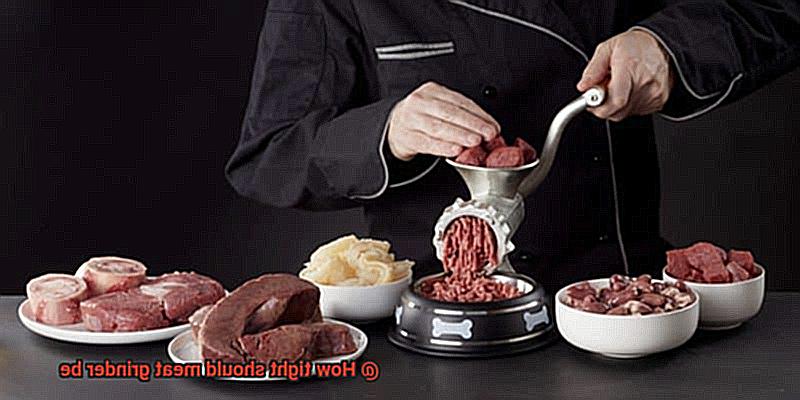
Electric Meat Grinders
Electric meat grinders are more expensive than manual ones, but they are more convenient and efficient. They come in a range of sizes, from small countertop models to larger floor-standing units.
Electric grinders are ideal for those who want to grind large quantities of meat quickly and easily. Some electric grinders come with features such as multiple grinding plates, sausage stuffing attachments, and reverse functions.
These features allow you to customize your grinding experience and achieve the desired texture and consistency. They save time and effort and can handle tougher cuts of meat with ease. However, they are less portable than manual grinders and require a power source.
Cleaning Your Meat Grinder
Meat grinders should be cleaned thoroughly after each use to prevent bacteria growth. Most grinders come apart easily, making cleaning a quick and simple process. It is recommended that you clean your grinder by hand rather than using a dishwasher, as dishwashers can damage the grinder’s parts. Make sure to clean all parts of the grinder, including the blades and plates.
Factors to Consider When Tightening a Meat Grinder
There are specific factors to consider to ensure safety and optimal performance. Let me guide you through the essential factors to consider when tightening your meat grinder.
Firstly, it’s vital to know the type of grinder you have. Manual grinders require more effort to tighten than electric grinders, which often come with an automatic locking mechanism. So if you’re using a manual grinder, be prepared to put in a bit more elbow grease to tighten the locking nut or screw.
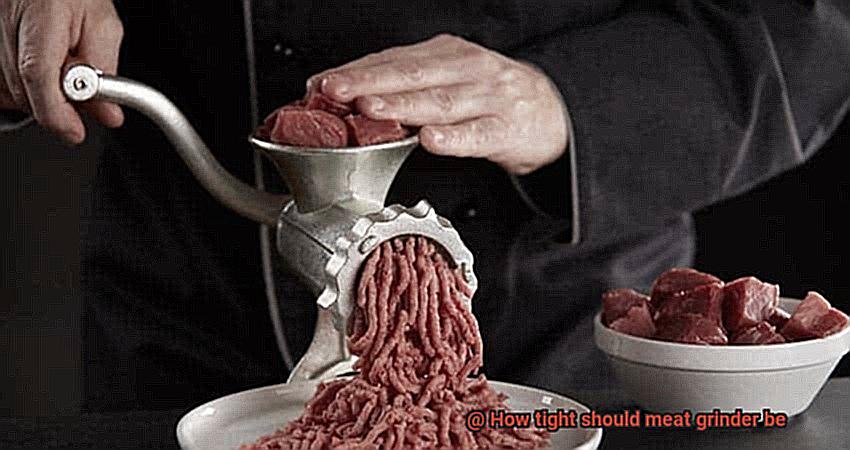
The size of your grinder also plays a role in how much force you need to apply when tightening it. Larger grinders will require more force, while smaller grinders may only need a slight turn of the locking mechanism. But be careful not to over-tighten your grinder, as this can cause damage to the machine and even lead to injury.
Another important factor is the material of your grinder. Stainless steel grinders are usually more durable and require less tightening than plastic or aluminum ones. However, even with sturdy stainless steel grinders, it’s still essential to check the tightness before each use for optimal performance and safety.
When grinding different types of meat, consider adjusting the tightness accordingly. Tougher cuts of meat like beef or pork may require a tighter setting, while softer meats like chicken or fish may need a looser setting. And if you’re grinding bone-in meats, ensure that the grinder is tightened securely to prevent any damage or injury.
The Squeeze Test
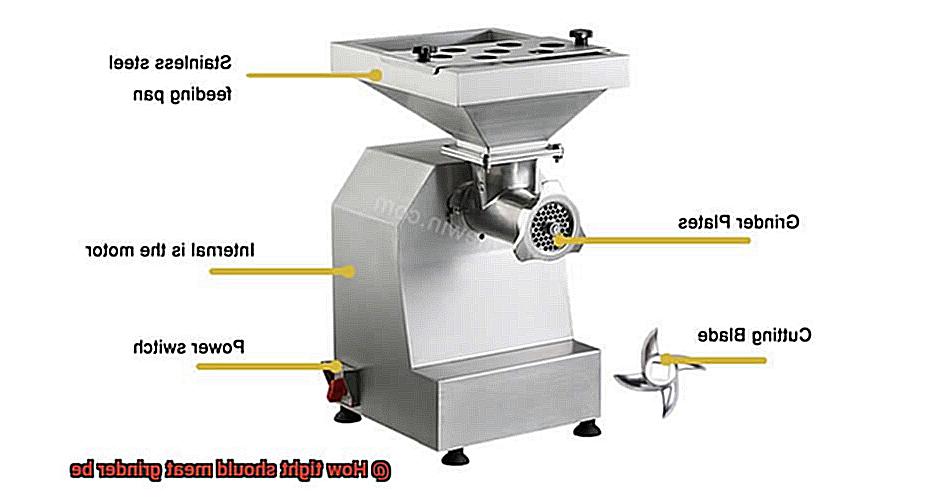
The Squeeze Test is a quick and easy way to determine the proper tightness of your meat grinder. To perform the test, start by turning on your grinder and feeding a piece of meat into it. Then, using either pliers or your fingers, gently squeeze the meat as it comes out of the grinder.
If the meat comes out too quickly and feels loose, then your meat grinder is likely too loose. This can lead to unevenly ground meat and even cause the meat to get stuck in the grinder. On the other hand, if the meat comes out too slowly and feels tight, then your meat grinder is likely too tight. This can strain the motor and potentially damage the blades.
The key to finding the sweet spot is to look for smooth and steady output with just a slight resistance when squeezing. This indicates that your meat grinder is properly tightened and ready for use.
It’s worth noting that different types of meat may require slightly different levels of tightness. For example, tougher cuts like beef may require a tighter setting than softer meats like chicken or pork. Therefore, performing the Squeeze Test before each use becomes crucial, especially when grinding different types of meats.
Different Types of Meat Require Different Levels of Tightness
When it comes to grinding meat, achieving the perfect texture and consistency can make all the difference in your dishes. However, it’s important to keep in mind that different types of meat require different levels of tightness in the meat grinder. Here are five key factors to consider when grinding different types of meats.
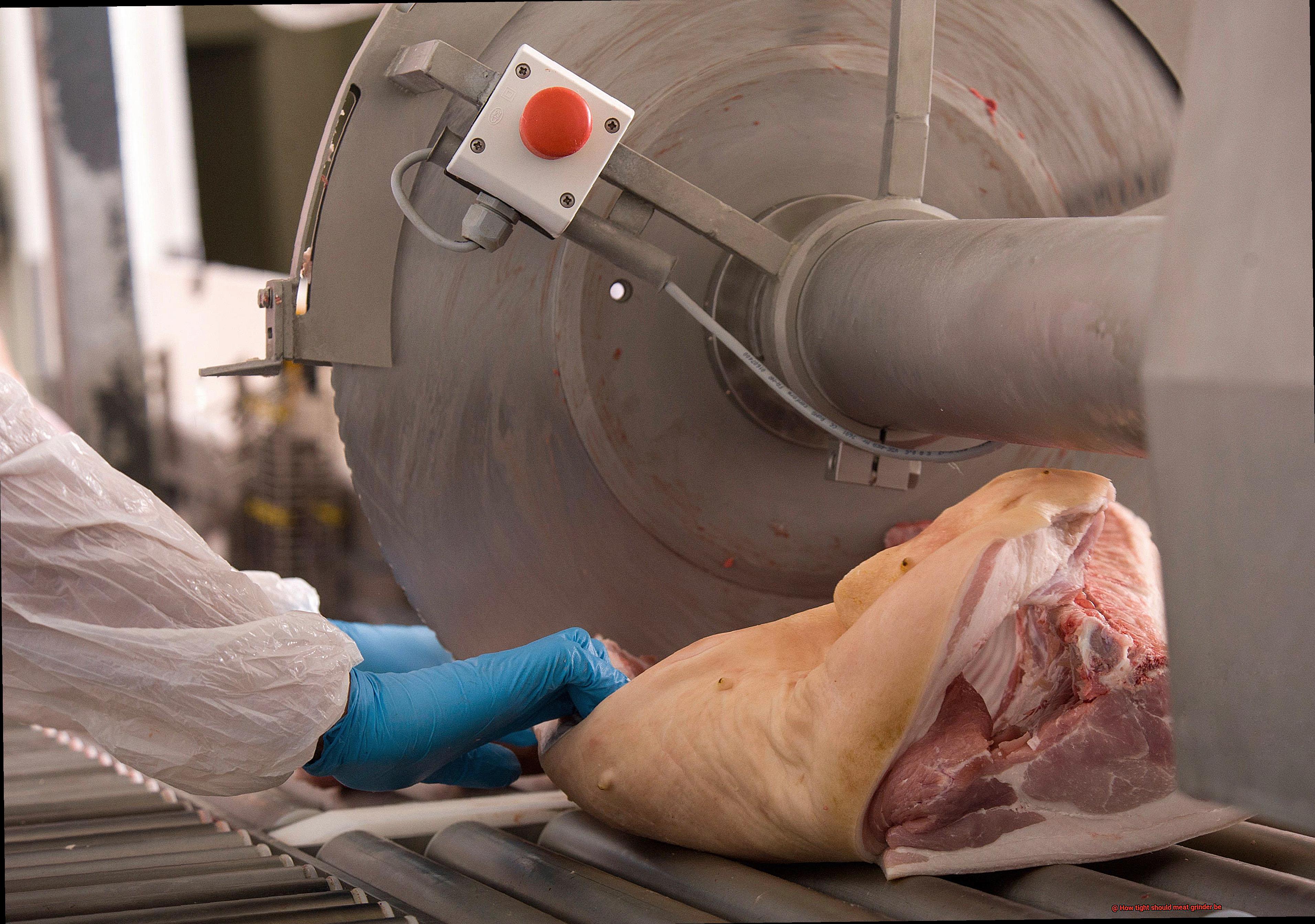
Tough Cuts of Beef
If you’re working with tough cuts of beef, like chuck or brisket, you’ll need to set your grinder to a tighter setting. This is because these cuts have more muscle fibers and connective tissue that need to be broken down through the grinding process. Setting the grinder too loose can result in a rough and chewy texture, while setting it too tight can damage your machine.
Fatty Meats
On the other hand, fattier cuts of meat like pork shoulder or bacon require a looser setting to prevent the fat from clogging up the grinder. The fat content adds moisture and flavor to the meat, but too much fat can cause problems in the grinding process. It’s important to find the right balance between texture and fat content for best results.
Lean Cuts of Meat
Leaner cuts of meat such as chicken breast or turkey require a tighter setting to ensure they are properly ground. These meats have less fat content and more delicate textures, so a looser setting can result in a mushy texture.
Size of Grind
The size of grind you want also affects how tight your grinder should be. A coarse grind requires a looser setting on your grinder, while a finer grind will need a tighter setting. Keep in mind that different dishes call for different grinds, so it’s important to adjust accordingly.
Different Grinders
It’s important to note that not all grinders are created equal. Different models may have different settings and mechanisms for adjusting the tightness. Always refer to the manufacturer’s instructions before using any new equipment, and test a small amount of meat before grinding an entire batch to ensure you have set the grinder to the appropriate level for your specific needs.
Manual Hand-Crank Grinders vs Electric Grinders
You might be wondering whether to choose a manual hand-crank grinder or an electric grinder. Both types of grinders have their unique features and benefits, so let’s dive into the differences between them.
Firstly, manual hand-crank grinders are ideal for those who prefer a more hands-on approach to cooking. These grinders require physical effort as you turn the handle to rotate the auger and push the meat through the grinding plates. The tightness of the grinder can be adjusted with a screw on the end of the device, allowing you to produce finer or coarser ground meat depending on your preference. However, this type of grinder can be tiring to use, especially if you are grinding large quantities of meat.
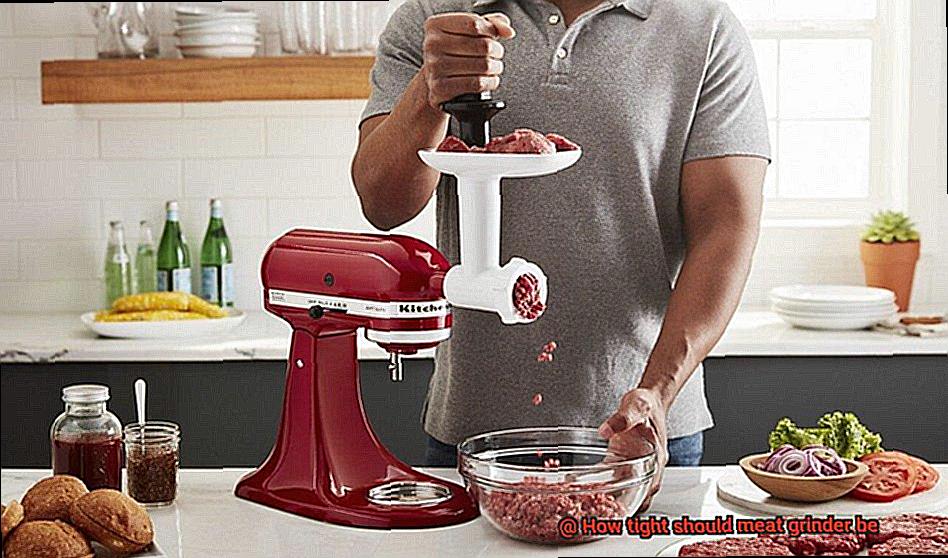
On the other hand, electric grinders are fast and efficient as they use a motor to rotate the auger and grind the meat. These grinders are perfect for busy kitchens where time is of the essence. The tightness of an electric grinder can be adjusted by changing the distance between the grinding plates, allowing you to produce finer or coarser ground meat as per your requirements. However, electric grinders can be noisy and may overheat if used for prolonged periods.
When it comes to determining how tight your grinder should be, it largely depends on your personal preference and what type of meat you are grinding. For example, if you are grinding lean meats like turkey breast or chicken breast, you may want to tighten the grinder to produce a finer grind. However, if you are grinding fatty meats like pork shoulder or beef chuck, you may want to loosen the grinder to prevent clogging or jamming.
In summary, both manual hand-crank grinders and electric grinders can produce fine or coarse ground meat depending on how tight they are set. The choice between them ultimately comes down to your personal preferences and needs. To find the perfect grinder for you, experiment with different settings and see what works best for your specific situation. Happy grinding.
Finding the Right Balance in Terms of Tightness
The first step is to consider the type of meat you plan on grinding. Different meats have varying levels of toughness and fat content, which means they require different levels of tightness. For instance, if you’re grinding beef or venison, you may need to tighten your meat grinder more than if you’re grinding chicken or pork.
But that’s not all. You also need to take into account the size of the grinding plate you’re using. Larger plates require a looser fit than smaller plates, as they need more space for the meat to pass through. So, if you’re using a larger plate, make sure that your grinder isn’t too tight, or else you’ll end up with unevenly ground meat.
Another factor to keep in mind is the amount of meat you’re grinding. If you’re grinding large batches of meat, be sure to adjust the tightness throughout the process to prevent overheating and ensure consistent results.
Ultimately, finding the right balance in terms of tightness requires some trial and error. Start with a looser fit and gradually tighten until you reach the desired texture and consistency. And remember, it’s always better to err on the side of being too loose rather than too tight. An overly tight fit can cause your meat grinder to overheat and lead to burnt or unevenly ground meat.
Tips for Tightening a Meat Grinder Properly
Tightening a meat grinder properly is crucial for safe and effective use. Here are five steps to follow to ensure your meat grinder is tightly secured:
Step 1: Turn off and unplug the machine
Before tightening anything, make sure that your meat grinder is turned off and unplugged. This is important for your safety and will prevent any damage to the machine.
Step 2: Check the manual
Check your manual or manufacturer’s instructions for specific guidelines on how tight the grinder should be. Over-tightening can cause damage, and under-tightening can lead to inconsistent grinding results. A snug fit is generally recommended, but not so tight that it’s difficult to turn the handle.
Step 3: Clean all parts
Make sure that all parts of your meat grinder are clean and free from debris before tightening. This will help ensure a secure fit and prevent any damage or malfunctioning during use.
Step 4: Use a rubber mat or grip pad
Using a rubber mat or grip pad can provide extra traction and leverage when tightening the parts. This can prevent slipping or overcompensating with too much force.
Step 5: Check and retighten periodically
The vibrations and pressure from grinding meat can cause screws and nuts to loosen over time. So, it’s important to check and retighten everything as needed before each use.
Common Mistakes to Avoid When Using a Meat Grinder
It’s important to use it correctly to avoid making common mistakes that can lead to poor results or even damage the equipment. In this article, we’ll explore the top common mistakes to avoid when using a meat grinder.
Firstly, not tightening the grinder enough can cause serious damage. A loose grinder can cause meat to get stuck in the machine, leading to jamming and even damage to the grinder itself. Therefore, ensure that your grinder is tightly secured before use by following the manual’s instructions. It’s also important to periodically check that it’s still tight after grinding for a while.
Another common mistake is using the wrong type of meat for grinding. Not all meats are suitable for grinding, and using the wrong type can result in poor results. Fatty meats like beef and pork are great for grinding as they produce a juicy and flavorful result. However, lean meats like chicken or turkey can be more difficult to grind and tend to produce a drier texture. Therefore, make sure you choose the right type of meat for your recipe.
A third common mistake when using a meat grinder is not cleaning it properly. Meat grinders can be challenging to clean, especially if you have ground a lot of meat. However, it’s essential to clean the grinder thoroughly after each use to prevent bacteria from growing inside the machine. Disassemble the grinder and wash each part separately with warm soapy water. You can also use a toothbrush or cleaning tool to reach tight spaces.
Lastly, not using the meat grinder correctly is one of the most significant mistakes people make. While it may seem straightforward, there are specific steps that need to be followed for optimal results. Firstly, cut the meat into small pieces before grinding, ensuring that it passes through the machine smoothly. Secondly, use a coarse grind plate for larger cuts of meat and a fine grind plate for smaller cuts. Lastly, avoid overfilling the grinder with meat as it can cause jamming and damage to the machine.
uF4B1ZK0h0A” >
Conclusion
In conclusion, the art of grinding meat is not a one-size-fits-all process. It requires careful consideration of several factors to achieve the perfect grind and elevate your culinary game. Whether you’re using a manual or electric meat grinder, adjusting its tightness is key.
The tightness of your meat grinder depends on various factors such as the type of meat, texture of the grind, and type of grinder. To ensure optimal performance and safety, it’s crucial to follow the manufacturer’s instructions when tightening your meat grinder. Consider factors like the size of grinding plate, type of meat being ground, and amount of meat being used to find the right balance in terms of tightness.
But how do you know if your grinder is properly tightened? Use the Squeeze Test before each use to determine if your grinder is set correctly. Avoid common mistakes like not tightening the grinder enough, using the wrong type of meat, not cleaning it properly, and not using it correctly.
By following these tips and tricks, you’ll be able to achieve that perfect grind every time and take your cooking game to new heights. So go ahead and experiment with different types of meats and textures – just remember to adjust your grinder’s tightness accordingly.


